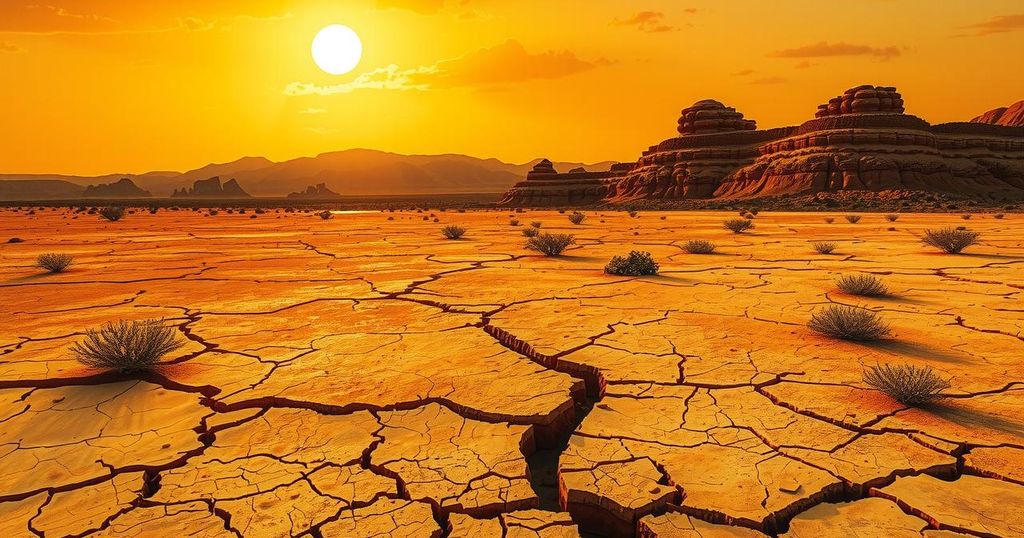Extreme Heat Sears Cities Across Pakistan
A severe heatwave is currently hitting Pakistan, with cities in Punjab reporting temperatures exceeding 45°C, and places like Jacobabad reaching 49°C. Hospitals are facing an influx of heatstroke cases, prompting authorities to take action. The heat is expected to persist for another few days, intensifying the risk for vulnerable populations. Government measures aim to mitigate the situation, urging residents to stay hydrated and minimize outdoor activities.
Extreme heat conditions are affecting cities across Pakistan, persisting since last week. Reports indicate that nearly all cities in Punjab are experiencing temperatures soaring over 45 degrees Celsius. Bhakkar and Jacobabad in Sindh have reached alarming highs of 49 degrees Celsius. The Pakistan Meteorological Department forecasts that this scorching weather will continue throughout the day, emphasizing mainly hot and dry conditions in most parts of the country, particularly in the plains.
Additionally, the Met Department cautioned about potential gusty winds that could occur during the afternoon. Some areas, specifically upper Khyber Pakhtunkhwa, the Potohar region, Kashmir, and Gilgit-Baltistan, might experience isolated rain or thunderstorms in the evenings. The Provincial Disaster Management Authority (PDMA) shared that extreme temperatures were reported in Sargodha at 47.8°C, Gujranwala and Hafizabad at 47.5°C, and Lahore at 46.2°C. The only refuge was found in the hill station of Murree, where temperatures reached a cooler 32°C.
Beyond Punjab, other regions are feeling the heat, halting daily life. In Sindh, Jacobabad recorded a sweltering 49 degrees Celsius, and Mohenjo-Daro was close behind at 48 degrees. Further south, Larkana and Sukkur reported temperatures of 47 degrees Celsius, while Karachi, with its high humidity, felt unbearable at 40 degrees Celsius. The plains of Khyber Pakhtunkhwa, including cities like Peshawar and Dera Ismail Khan, faced similar extreme temperatures between 45-46 degrees.
In stark contrast, the cooler mountainous regions remained somewhat insulated from the heat. Balochistan’s Sibi and Turbat reached 47 degrees, while Quetta was at a less oppressive 38 degrees. Observers noted that streets seemed deserted throughout the afternoon, with many people opting to stay indoors. Muhammad Asif, a rickshaw driver in Lahore, voiced the sentiments of many, stating, “The heat is unbearable. Even standing in the shade feels like being in an oven.”
Hospitals in Punjab have seen a surge in heatstroke cases, especially among laborers, children, and the elderly. In response, authorities have established emergency counters in state-run hospitals to address this influx. The situation has been aggravated due to ongoing power outages across various cities, leaving residents without essential cooling systems.
The National Disaster Management Authority has advised all provincial departments to remain alert as the heatwave lingers. In an effort to combat the impact of the extreme heat, the Punjab government has implemented measures to support affected individuals. Relief Commissioner Nabil Javed instructed local officials to remain vigilant and informed that the authorities are distributing cool drinking water in public areas, including transport hubs and markets. Hospitals have also been stocked with necessary medical supplies for treating heat-related ailments.
The government is urging citizens to take precautions, like staying hydrated and minimizing outdoor activities between 11 a.m. and 4 p.m. Additionally, residents are advised to wear light-colored clothing and seek cooler environments, particularly children, the elderly, and those with health conditions, who are at greater risk. If anyone experiences symptoms of heatstroke, they are encouraged to contact the PDMA’s emergency helpline at 1129.
Predictably, the Pakistan Meteorological Department warns that this heatwave shows no signs of relief, projecting about 48 to 72 hours of continuous high temperatures. PDMA Director General Irfan Ali Kathia underscored the seriousness of the situation, declaring, “This is a life-threatening situation,” and highlighted the urgency of protecting vulnerable populations during this intense weather period.
The extreme heatwave gripping Pakistan is posing serious challenges across multiple cities, with temperatures in Punjab soaring to as high as 49 degrees Celsius. The heat has disrupted daily life, affected health, and placed stress on public services. With no immediate respite in sight, government agencies are mobilizing resources to keep citizens safe and provide necessary support. As citizens are urged to be cautious and stay informed, the country braces for the ongoing heat crisis.
Original Source: asianews.network




Post Comment